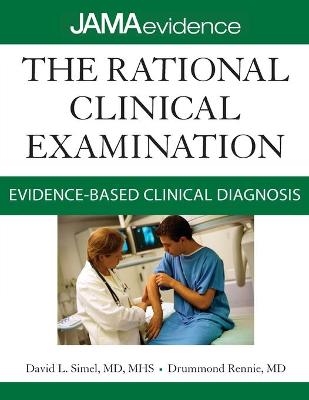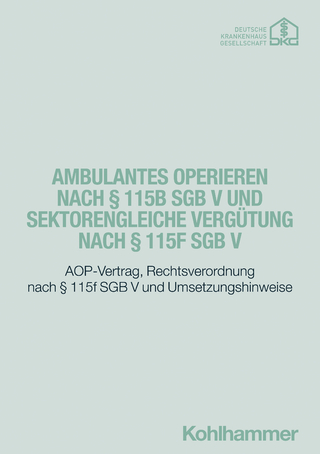
The Rational Clinical Examination: Evidence-Based Clinical Diagnosis
McGraw-Hill Medical (Verlag)
978-0-07-159030-3 (ISBN)
Publisher's Note: Products purchased from Third Party sellers are not guaranteed by the publisher for quality, authenticity, or access to any online entitlements included with the product.
The ultimate guide to the evidence-based clinical encounter
A Doody's Core Title for 2015!
"This book is an excellent source of supported evidence that provides useful and clinically relevant information for the busy practitioner, student, resident, or educator who wants to hone skills of physical diagnosis. It provides a tool to improve patient care by using the history and physical examination items that have the most reliability and efficiency."--Annals of Internal Medicine
"The evidence-based examination techniques put forth by Rational Clinical Examination is the sort that can be brought to bear on a daily basis – to save time, increase confidence in medical decisions, and help decrease unnecessary testing for conditions that do not require absolute diagnostic certainty. In the end, the whole of this book is greater than its parts and can serve as a worthy companion to a traditional manual of physical examination."--Baylor University Medical Center (BUMC)Proceedings
5 STAR DOODY'S REVIEW!
"Physical diagnosis has been taught to every medical student but this evidence-based approach now shows us why, presenting one of medicine's most basic tenets in a new and challenging light. The format is extraordinary, taking previously published material and updating the pertinent evidence since the initial publication, affirming or questioning or refining the conclusions drawn from the data.
"This is a book for everyone who has studied medicine and found themselves doubting what they have been taught over the years, not that they have been deluded, but that medical traditions have been unquestionably believed because there was no evidence to believe otherwise. The authors have uncovered the truth.
"This extraordinary, one-of-a-kind book is a valuable addition to every medical library."--Doody's Review Service
Completely updated with new literature analyses, here is a uniquely practical, clinically relevant approach to the use of evidence in the content of physical examination. Going far beyond the scope of traditional physical examination texts, this invaluable resource compiles and presents the evidence-based meanings of signs, symptoms, and results from physical examination maneuvers and other diagnostic studies. Page after page, you'll find a focus on actual clinical questions and presentations, making it an incomparably practical resource that you'll turn to again and again.
Importantly, the high-yield content of The Rational Clinical Examination is significantly expanded and updated from the original JAMA articles, much of it published here for the first time. It all adds up to a definitive, ready-to-use clinical exam sourcebook that no student or clinician should be without.
FEATURES
Packed with updated, new, and previously unpublished information from the original JAMA articles
Standardized template for every issue covered, including: Case Presentation; Why the Issue Is Clinically Important; Research and Statistical Methods Used to Find the Evidence Presented; The Sensitivity and Specificity of Each Key Result; Resolution of the Case Presentation; and the Clinical Bottom Line
Completely updated with all-new literature searches and appraisals supplementing each chapter
Full-color format with dynamic clinical illustrations and images
Real-world focus on a specific clinical question in each chapter, reflecting the way clinicians approach the practice of evidence-based medicine
More than 50 complete chapters on common and challenging clinical questions and patient presentations
Also available: JAM
David Simel, MD, MHS, Chief, Medicine Service Durham Veterans Affairs Medical Center Professor of Medicine Duke University School of Medicine Durham, NC Drummond Rennie, MD JAMA Chicago, IL Philip R. Lee Institute for Health Policy Studies University of California, San Francisco San Francisco, CA
Contributors
Foreword
Preface
Acknowledgments
1.A Primer on the Precision and Accuracy of the Clinical Examination
UPDATE: Primer on Precision and Accuracy
2.Does This Patient Have Abdominal Aortic Aneurysm?
UPDATE: Abdominal Aortic Aneurysm
3.Does This Patient Have Abdominal Bruits Useful in the Evaluation of Hypertension?
UPDATE: Abdominal Bruits
4.Does This Patient Have an Alcohol Problem?
UPDATE: Problem Alcohol Drinking
5.Does This Adult Patient Have Appendicitis?
UPDATE: Appendicitis, Adult
6.Does This Patient Have Ascites?
UPDATE: Ascites
7.What Can the Medical History and Physical Examination Tell Us About LowBack Pain?
UPDATE: Low Back Pain
8.Does This Patient Have Breast Cancer?
UPDATE: Breast Cancer
9.Does This Patient Have a Clinically Important Carotid Bruit?
UPDATE: Carotid Bruit
10.Does This Patient Have Carpal Tunnel Syndrome?
UPDATE: Carpal Tunnel
11.Does This Patient Have Abnormal Central Venous Pressure?
UPDATE: Central Venous Pressure
12.Does This Patient Have Acute Cholecystitis?
UPDATE: Cholecystitis
13.Does the Clinical Examination Predict Airflow Limitation?
UPDATE: Chronic Obstructive Airways Disease
14.Does This Patient Have Clubbing?
UPDATE: Clubbing
15.Is This Patient Taking the Treatment as Prescribed?
UPDATE: Compliance and Medication Adherence
16(A).Can the Clinical Examination Diagnose Left-Sided Heart Failure in Adults?
16(B). Does This Dyspneic Patient in the Emergency Department Have Congestive Heart Failure?
UPDATE: Congestive Heart Failure
17.Is This Patient Dead, Vegetative, or Severely Neurologically Impaired? Assessing Outcome for Comatose Survivors of Cardiac Arrest
UPDATE: Death
18(A).Does This Patient Have Deep Vein Thrombosis? (1998)
18(B). Does This Patient Have Deep Vein Thrombosis? (2006)
UPDATE: Deep Vein Thrombosis
19.Is This Patient Clinically Depressed?
UPDATE: Depression
20.Does This Patient Have a Family History of Cancer?
UPDATE: Family History of Cancer
21.Does This Patient Have a Goiter?
UPDATE: Goiter
22.Does This Patient Have Hepatomegaly?
UPDATE: HepatomegalyUPDATE: Hypertension
24.Is This Adult Patient Hypovolemic?
UPDATE: Hypovolemia, Adult
25.Is This Child Dehydrated?
UPDATE: Hypopvolemia, Child
26.Does This Patient Have Influenza?
UPDATE: Influenza
27.Does This Patient Have a Torn Meniscus or Ligament of the Knee?
UPDATE: Knee Ligaments and Menisci
28.Is This Adult Patient Malnourished?
UPDATE: Malnourishment, Adult
29.Does This Patient Have a Mole or a Melanoma?
UPDATE: Melanoma
30.Does This Adult Patient Have Acute Meningitis?
UPDATE: Meningitis, Adult
31.Is This Woman Perimenopoausal?
UPDATE: Menopause
32.Does This Patient Have Aortic Regurgitation?
UPDATE: Murmur, Diastolic
33.Does This Patient Have an Abnormal Systolic Murmur?
UPDATE: Murmur, Systolic
34.Does This Patient Have Myasthenia Gravis?
UPDATE: Myasthenia Gravis
35.Is This Patient Having a Myocardial Infarction?
UPDATE: Myocardial Infarction
36.Does This Woman Have Osteoporosis?
UPDATE: Osteoporosis
37.Does This Child Have Acute Otitis Media?
UPDATE: Otitis Media, Child
38.Does This Patient Have Parkinson Disease?
UPDATE: Parkinsonism
39.Is This Patient Allergic to Penicillin?
UPDATE: Penicillin Allergy
40.Does This Adult Patient Have Community-Acquired Pneumonia?
UPDATE: Community-Acquired Pneumonia, Adult
41.Does This Infant Have Pneumonia?
UPDATE: Pneumonia, Infant and Child
42.Is This Patient Pregnant?
UPDATE: Early Pregnancy
43.Does This Patient Have Pulmonary Embolism?
UPDATE: Pulmonary Embolism
44.Does This Patient Have an Instability of the Shoulder or a Labrum Lesion?
UPDATE: Shoulder Instability
45.Does This Patient Have Sinusitis?
UPDATE: Sinusitis
46.Does This Patient Have Splenomegaly?
UPDATE: Splenomegaly
47.Does This Patient Have Strep Throat?
UPDATE: Streptococcal Pharyngitis
48.Is This Patient Having a Stroke?
UPDATE: Stroke
49.Does This Patient Have Temporal Arteritis?
UPDATE: Temporal Arteritis
50.Does This Patient Have an Acute Thoracic Aortic Dissection?
UPDATE: Thoracic Aortic Dissection
51.Does This Woman Have an Acute Uncomplicated Urinary Tract Infection?
UPDATE: Urinary Tract Infection, Women
52.What is Causing This Patient's Vaginal Symptoms?
UPDATE: Vaginitis
53.Does This Dizzy Patient Have a Serious Form of Vertigo?
UPDATE: Vertigo
Index
| Erscheint lt. Verlag | 16.10.2008 |
|---|---|
| Zusatzinfo | 100 Illustrations |
| Verlagsort | New York |
| Sprache | englisch |
| Maße | 213 x 274 mm |
| Gewicht | 2096 g |
| Themenwelt | Medizin / Pharmazie ► Gesundheitswesen |
| ISBN-10 | 0-07-159030-7 / 0071590307 |
| ISBN-13 | 978-0-07-159030-3 / 9780071590303 |
| Zustand | Neuware |
| Haben Sie eine Frage zum Produkt? |
aus dem Bereich


